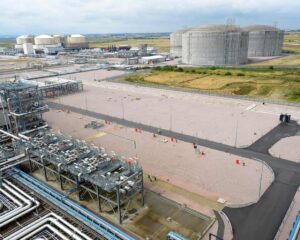
In a significant pivot from its previous stance, Canada has launched its first operational liquefied natural gas (LNG) export terminal, marking a potential new chapter in the country’s energy policy. This development comes after years of governmental resistance to fossil fuel investments, highlighted by a 2024 statement from then-resource minister Jonathan Wilkinson, who declared, “We are not interested in investing in LNG facilities.” Yet, this month, LNG Canada shipped its inaugural cargo, signaling a shift in Canada’s approach to its abundant hydrocarbon resources.
The launch of LNG Canada, a project spearheaded by a consortium of energy giants including Shell, Malaysia’s Petrobas, Japan’s Mitsubishi, Korea’s Kogas, and PetroChina, represents a strategic move to tap into the Asian energy market. The choice of market is driven by two primary factors: the geographical proximity of Canada’s west coast to Asia, which reduces transportation costs, and the current lower trading price of Canadian natural gas compared to U.S. gas.
Historical Context and Policy Shifts
For years, Canadian federal governments, particularly under Prime Minister Justin Trudeau, have been vocal opponents of the oil and gas industry. The Trudeau administration implemented stringent regulations and increased red tape, making it challenging for companies to expand their operations. This was the backdrop against which Wilkinson made his anti-LNG statement, emphasizing the government’s preference for carbon taxes and subsidies for electric vehicles over fossil fuel investments.
However, the private sector, taking Wilkinson’s advice to assess the business case independently, proceeded with investments in LNG. This culminated in the establishment of LNG Canada, a landmark project aimed at diversifying Canada’s energy exports and enhancing its role in global energy markets.
Government’s New Energy Strategy
Prime Minister Mark Carney has articulated a vision of transforming Canada into an energy superpower, a notable departure from the previous administration’s focus on emission reductions. Carney has publicly embraced a broader spectrum of energy sources, positioning this shift as a response to U.S. trade policies under President Trump, which have disrupted traditional trade routes and presented new opportunities for Canadian energy exports.
“These [LNG] projects are part of our broader strategy to protect Canada’s energy security, diversify our trade, and enhance our long-term competitiveness, all while building the most reliable, low-carbon energy possible,” said Tim Hodgson, Carney’s energy minister, as quoted by the Financial Times.
Carney’s administration has temporarily paused the carbon tax for households, a move that has been welcomed by many Canadians who blame the tax for declining living standards. However, the pause does not extend to companies, indicating that Canada remains committed to its net-zero goals, albeit with a more balanced approach to energy policy.
Market Dynamics and Future Prospects
Despite the positive reception of LNG Canada’s first shipment, some skepticism remains about the long-term viability of expanding LNG capacity. Critics argue that global demand does not justify further investments, citing potential overcapacity issues. However, industry analysts point to infrastructure challenges as a more immediate concern, as these can significantly increase costs for new projects.
Ultimately, the market will determine the future of LNG in Canada. If demand continues to grow, particularly in Asia, it could spur additional investments in LNG export facilities. This would require net-zero advocates to reconcile with the ongoing demand for fossil fuels, despite previous predictions of stranded assets to meet global warming targets.
As Canada navigates this complex energy landscape, the balance between environmental commitments and economic opportunities will remain a central theme in its policy decisions. The success of LNG Canada could serve as a bellwether for the country’s future energy strategy, reflecting a pragmatic approach to leveraging its natural resources while adapting to global energy dynamics.







